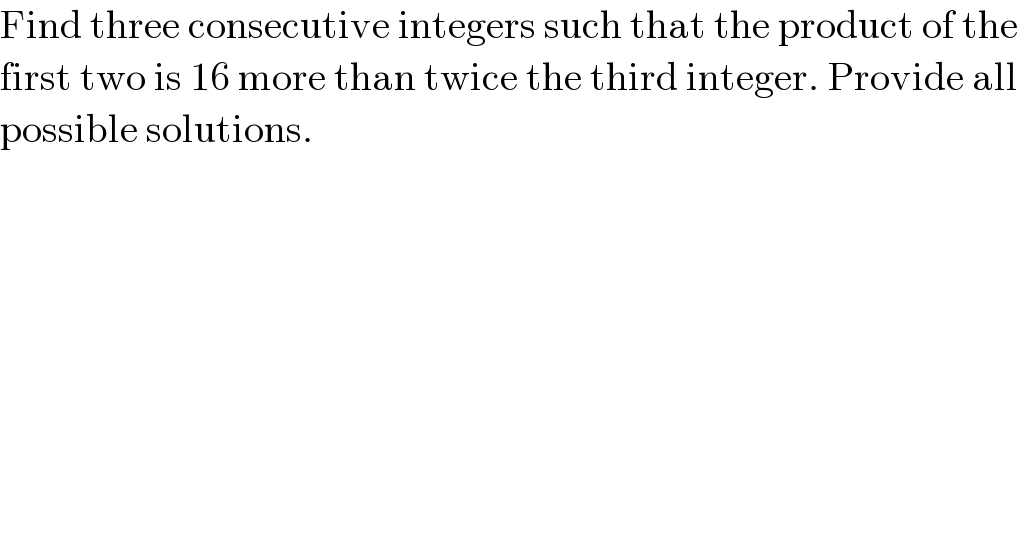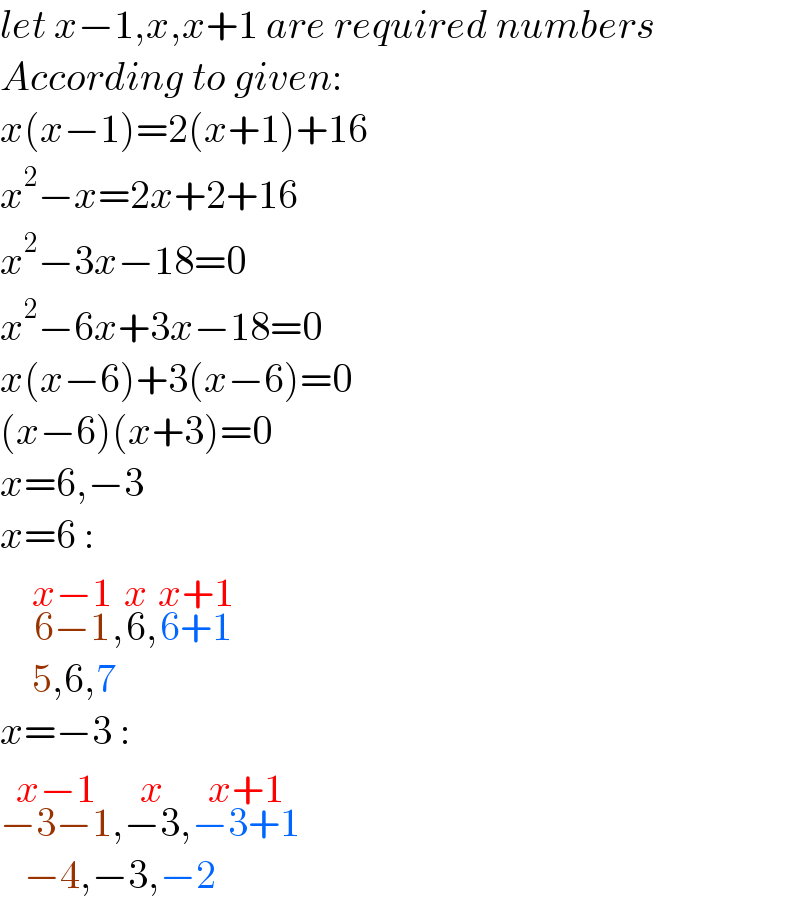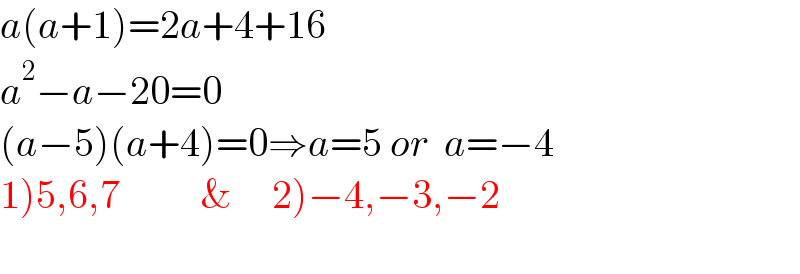
Question Number 217321 by ArshadS last updated on 10/Mar/25

$$\mathrm{Find}\:\mathrm{three}\:\mathrm{consecutive}\:\mathrm{integers}\:\mathrm{such}\:\mathrm{that}\:\mathrm{the}\:\mathrm{product}\:\mathrm{of}\:\mathrm{the}\: \\ $$$$\mathrm{first}\:\mathrm{two}\:\mathrm{is}\:\mathrm{16}\:\mathrm{more}\:\mathrm{than}\:\mathrm{twice}\:\mathrm{the}\:\mathrm{third}\:\mathrm{integer}.\:\mathrm{Provide}\:\mathrm{all}\: \\ $$$$\mathrm{possible}\:\mathrm{solutions}. \\ $$
Answered by Rasheed.Sindhi last updated on 10/Mar/25

$${let}\:{x}−\mathrm{1},{x},{x}+\mathrm{1}\:{are}\:{required}\:{numbers} \\ $$$${According}\:{to}\:{given}: \\ $$$${x}\left({x}−\mathrm{1}\right)=\mathrm{2}\left({x}+\mathrm{1}\right)+\mathrm{16} \\ $$$${x}^{\mathrm{2}} −{x}=\mathrm{2}{x}+\mathrm{2}+\mathrm{16} \\ $$$${x}^{\mathrm{2}} −\mathrm{3}{x}−\mathrm{18}=\mathrm{0} \\ $$$${x}^{\mathrm{2}} −\mathrm{6}{x}+\mathrm{3}{x}−\mathrm{18}=\mathrm{0} \\ $$$${x}\left({x}−\mathrm{6}\right)+\mathrm{3}\left({x}−\mathrm{6}\right)=\mathrm{0} \\ $$$$\left({x}−\mathrm{6}\right)\left({x}+\mathrm{3}\right)=\mathrm{0} \\ $$$${x}=\mathrm{6},−\mathrm{3} \\ $$$${x}=\mathrm{6}\:: \\ $$$$\:\:\:\:\overset{{x}−\mathrm{1}} {\mathrm{6}−\mathrm{1}},\overset{{x}} {\mathrm{6}},\overset{{x}+\mathrm{1}} {\mathrm{6}+\mathrm{1}}\: \\ $$$$\:\:\:\:\mathrm{5},\mathrm{6},\mathrm{7} \\ $$$${x}=−\mathrm{3}\:: \\ $$$$\overset{{x}−\mathrm{1}} {−\mathrm{3}−\mathrm{1}},\overset{{x}} {−\mathrm{3}},\overset{{x}+\mathrm{1}} {−\mathrm{3}+\mathrm{1}} \\ $$$$\:\:\:−\mathrm{4},−\mathrm{3},−\mathrm{2} \\ $$
Commented by ArshadS last updated on 10/Mar/25

$${Right}! \\ $$
Answered by mehdee7396 last updated on 10/Mar/25

$${a}\left({a}+\mathrm{1}\right)=\mathrm{2}{a}+\mathrm{4}+\mathrm{16} \\ $$$${a}^{\mathrm{2}} −{a}−\mathrm{20}=\mathrm{0} \\ $$$$\left({a}−\mathrm{5}\right)\left({a}+\mathrm{4}\right)=\mathrm{0}\Rightarrow{a}=\mathrm{5}\:{or}\:\:{a}=−\mathrm{4} \\ $$$$\left.\mathrm{1}\left.\right)\mathrm{5},\mathrm{6},\mathrm{7}\:\:\:\:\:\:\:\:\:\:\&\:\:\:\:\:\mathrm{2}\right)−\mathrm{4},−\mathrm{3},−\mathrm{2} \\ $$$$ \\ $$
Commented by ArshadS last updated on 10/Mar/25

$${Ok},\:{thanks}\:{sir}! \\ $$
